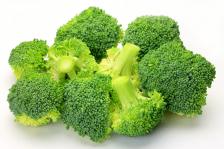Blood Thinners and Broccoli
People taking anticoagulants are usually told to avoid broccoli, spinach, and other super-healthy veggies. Nutrition Diva has a better idea.

“I recently developed a blood clot in my leg and my doctor put me on blood-thinners. The nurse handed me a print-out of foods that I shouldn’t eat because they would interact with the medicine—things like broccoli, kale, spinach, and Brussels sprouts. Since starting to listen to your show, I’ve been trying to /health-fitness/healthy-eating/how-to-get-more-vegetables-into-your-diet and I’ve been eating lots of the foods on this list. Could eating too many vegetables have caused my blood clot?”
Your efforts to eat something good for me didn’t backfire, Annie! The vegetables on this list are all high in vitamin K—an important nutrient that helps /health-fitness/prevention/diet-for-healthy-bones and protects against hardening of the arteries. But vitamin K gets its name from the German word for coagulation (which, in German, is spelled with a “k”). That’s because in addition to its many other jobs, this nutrient is required for proper blood clotting.
If you don’t get enough vitamin K in your diet, you might bruise easily or it might take a long time for a paper cut to stop bleeding. However, the opposite is not true: getting a lot of vitamin K in your diet doesn’t make you more likely to form a blood clot in a blood vessel.
Blood clots in the leg (/health-fitness/mens-health/what-is-deep-venous-thrombosis-dvts) are more likely to be caused by sitting for too long, such as on a long flight. Being laid up in bed for an extended period of time due to illness or injury can also increase the risk of DVTs, as can smoking or taking birth control pills or hormone replacement therapy. DVTs can cause pain and swelling, usually in the calf. But the real danger is that a piece of the clot might break free and travel through the circulatory system to the lungs or heart, where they can really wreak havoc.
Diet and Anticoagulants
Doctors use anticoagulants (or blood-thinning drugs) to help dissolve a blood clot before it causes trouble—or to prevent one from forming in the first place in people who are at increased risk. But giving anticoagulant medication is a delicate balancing act. You want to block enough of the coagulating activity to prevent inappropriate blood clotting, but not so much that you cause uncontrolled bleeding or hemorrhage elsewhere in the body. People taking blood-thinning medications have regular blood tests to be sure that the dosage is just right. And that’s where the vegetables come in.
Anticoagulant drugs work by blocking the action of vitamin K. The more vitamin K you’re consuming, the higher your dosage would need to be. Now, that wouldn’t be a problem if you consumed more or less the same amount of Vitamin K every day. Your dosage could be adjusted to accommodate that intake. But if your vitamin K intake fluctuated wildly from day to day, it would make it very hard to keep your coagulation levels in the target zone. And that’s why people who are prescribed blood-thinning medications are often advised to avoid vitamin K-rich foods altogether. It just keeps things simpler.
What About the Other Benefits of These Foods?
In addition to being high in vitamin K, broccoli, spinach, kale, and leafy greens contain important cancer-fighting compounds, vitamin A, fiber, and lots of other good stuff. It seems a shame to ban these healthy foods from your diet. People being treated for DVTs, like Annie, usually take blood thinning medications only for a short period of time, until the clot is dissolved. Avoiding vegetables high in vitamin K during this time will make it easier for the medication to work and won’t cause any nutritional hardships.
People who are at high risk of forming blood clots, on the other hand, take anticoagulant medication on an ongoing basis. Do they have to miss out on the all benefits of these super-nutritious vegetables forever? Not necessarily. There is a way for you to get all the health benefits of these foods without interfering with your blood-thinning therapy—but you’ll have to enlist your doctor’s help.
How to Have Your K and Eat it Too
You’ll still need that list of foods that are high in vitamin K. But instead of avoiding them completely, use that list to ensure that you’re getting about the same amount of vitamin K every day. Don’t worry about small variations from day to day—it’s the big picture we’re worried about here. The easiest thing might be to plan to eat one serving (but only one) of a vitamin K-rich vegetable every single day. At the same time, your doctor will need to test your blood-clotting time and adjust your blood-thinning medication (if needed) to accommodate the amount of vitamin K in your diet.
You’ll also want to be alert to warning signs…such as easy bruising or nosebleeds…and absolutely vigilant about showing up for your regular blood-testing appointments and following your doctor’s instructions regarding over-the-counter medications and supplements, which can also interact with anticoagulants.
If for whatever reason it might be difficult for you to hold up your end of the bargain—perhaps you travel a lot and don’t always have control over your menus—it’s probably safer to avoid vegetables high in vitamin K. In that case, simply eat as big a /health-fitness/healthy-eating/how-important-is-a-varied-diet and healthy foods as you can to maximize your intake of other protective nutrients.
And for those who are not on blood-thinning medication, I want to reassure you once again that eating vegetables high in vitamin K does not increase your risk of blood clots. In fact, a diet high in vegetables of all kinds is a great way to reduce your risk of /health-fitness/healthy-eating/ask-diva-can-beets-lower-blood-pressure.
Resources:
Broccoli image courtesy of Shutterstock


